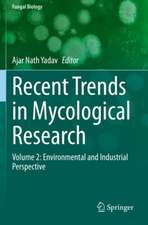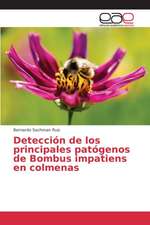Microbial Biotechnology Approaches to Monuments of Cultural Heritage
Editat de Ajar Nath Yadav, Ali Asghar Rastegari, Vijai Kumar Gupta, Neelam Yadaven Limba Engleză Paperback – 25 iun 2021
This book discusses a range of topics, including the biodiversity of microbial communities from various cultural heritage monuments, microbial biotechnological cleaning techniques, the role of bacterial fungal communities for the conservation of cultural heritage, and microbial enzymes and their potential applications as biorestoration agents. Written by internationally recognized experts, and providing up-to-date and detailed insights into microbial biotechnology approaches to cultural heritage monuments, the book is a valuable resource forbiological scientists, especially microbiologists, microbial biotechnologists, biochemists and microbial biotechnologists.
| Toate formatele și edițiile | Preț | Express |
|---|---|---|
| Paperback (1) | 692.88 lei 43-57 zile | |
| Springer Nature Singapore – 25 iun 2021 | 692.88 lei 43-57 zile | |
| Hardback (1) | 946.72 lei 43-57 zile | |
| Springer Nature Singapore – 25 iun 2020 | 946.72 lei 43-57 zile |
Preț: 692.88 lei
Preț vechi: 815.16 lei
-15% Nou
Puncte Express: 1039
Preț estimativ în valută:
132.58€ • 138.80$ • 109.70£
132.58€ • 138.80$ • 109.70£
Carte tipărită la comandă
Livrare economică 07-21 aprilie
Preluare comenzi: 021 569.72.76
Specificații
ISBN-13: 9789811534034
ISBN-10: 9811534039
Ilustrații: XV, 198 p. 19 illus., 13 illus. in color.
Dimensiuni: 155 x 235 mm
Greutate: 0.31 kg
Ediția:1st ed. 2020
Editura: Springer Nature Singapore
Colecția Springer
Locul publicării:Singapore, Singapore
ISBN-10: 9811534039
Ilustrații: XV, 198 p. 19 illus., 13 illus. in color.
Dimensiuni: 155 x 235 mm
Greutate: 0.31 kg
Ediția:1st ed. 2020
Editura: Springer Nature Singapore
Colecția Springer
Locul publicării:Singapore, Singapore
Cuprins
Chapter 1. Microbial Community Present on the Reverse Side of a Deteriorated Canvas.- Chapter 2. Microbial Biocleaning Technologies for Cultural Heritage: Current Status and Future Challenges.- Chapter 3. Role of Bacterial Communities to Prevent the Microbial Growth on Cultural Heritage.- Chapter 4. Entomogenous Fungi and the Conservation of the Cultural Heritage.- Chapter 5. Microorganisms and their Enzymes as Biorestoration Agents.- Chapter 6. Bioremediation of Cultural Heritage: Removal of Organic Substances.- Chapter 7. The Role Microorganisms for the Removal of Sulphates on Artistic Stoneworks.- Chapter 8. Microbiological Tools for Cultural Heritage Conservation.- Chapter 9. Biotechnology to Restoration and Conservation.- Chapter 10. Biocement: A novel approach in the restoration of construction materials.
Notă biografică
Ajar Nath Yadav is an assistant professor (Senior Scale) in the Department of Biotechnology, Eternal University, Baru Sahib, Himachal Pradesh, India. He has 10 years of teaching and research experiences. He obtained his doctorate degree in Microbial Biotechnology in 2016, jointly from Indian Agricultural Research Institute, New Delhi and Birla Institute of Technology, Mesra, Ranchi, India. Dr. Yadav has 133 publications with h-index 27, i10-index 63, and 2203 citations. Dr. Yadav has got 12 Best Paper Presentation Awards, and “Outstanding Teacher Award”-2018. He has the lifetime membership of Association of microbiologist in India, Indian Science Congress Council and National Academy of Sciences, India.
Ali Asghar Rastegari is currently working as an Assistant Professor in the Faculty of Biological Science, Department of Molecular and Cell Biochemistry, Falavarjan Branch, Islamic Azad University, Isfahan, I.R. Iran. Dr. Rastegari has 13 years of teaching and research experiences. Dr. Rastegari gained a Ph.D. in Molecular Biophysics, the University of Science and Research, Tehran Branch, IranIn his credit 18 research publications and published 12 abstracts in different conference. He has a lifetime membership of Iranian Society for Trace Elements Research (ISTER), The Biochemical Society of I.R.IRAN, and Member of Society for Bioinformatics in Northern Europe (SocBiN).
Vijai Kumar Gupta from ERA Chair of Green Chemistry, Department of Chemistry and Biotechnology, School of Science, Tallinn University of Technology, Tallinn, Estonia, is one of the leading experts in the area of microbial biology and biotechnology. He is the member of International Sub-commission on Trichoderma and Hypocrea, Austria; International Society for Fungal Conservation, UK; and Secretary of European Mycological Association. Dr. Gupta is the Fellow of Prestigious- The Linnaean Society, London, UK; Fellow of Indian Mycological Association; and Fellow of Mycological Society of India. He has been honored with several awards in his career including Indian Young Scientist Award for his advanced research achievements in the field of fungal biology and biotechnology. He is the editor of leading scientific journals of high repute and having many publications in his hands with h-index 34. He is editor of many books published by international publishers.
Neelam Yadav is senior researcher, currently working on microbial diversity from diverse sources and their biotechnological applications agriculture and allied sectors. She obtained her post graduation degree from Veer Bahadur Singh Purvanchal University, Uttar Pradesh, India. She has research interest in the area of probiotics microbes, and beneficial microbiomes from diverse sources. In her credit 35 publications in different reputed international, national journals and publishers. She is Editor/ reviewer of different international and national journals. She has the lifetime membership of Association of microbiologist in India, Indian Science Congress Council, India and National Academy of Sciences, India.
Ali Asghar Rastegari is currently working as an Assistant Professor in the Faculty of Biological Science, Department of Molecular and Cell Biochemistry, Falavarjan Branch, Islamic Azad University, Isfahan, I.R. Iran. Dr. Rastegari has 13 years of teaching and research experiences. Dr. Rastegari gained a Ph.D. in Molecular Biophysics, the University of Science and Research, Tehran Branch, IranIn his credit 18 research publications and published 12 abstracts in different conference. He has a lifetime membership of Iranian Society for Trace Elements Research (ISTER), The Biochemical Society of I.R.IRAN, and Member of Society for Bioinformatics in Northern Europe (SocBiN).
Vijai Kumar Gupta from ERA Chair of Green Chemistry, Department of Chemistry and Biotechnology, School of Science, Tallinn University of Technology, Tallinn, Estonia, is one of the leading experts in the area of microbial biology and biotechnology. He is the member of International Sub-commission on Trichoderma and Hypocrea, Austria; International Society for Fungal Conservation, UK; and Secretary of European Mycological Association. Dr. Gupta is the Fellow of Prestigious- The Linnaean Society, London, UK; Fellow of Indian Mycological Association; and Fellow of Mycological Society of India. He has been honored with several awards in his career including Indian Young Scientist Award for his advanced research achievements in the field of fungal biology and biotechnology. He is the editor of leading scientific journals of high repute and having many publications in his hands with h-index 34. He is editor of many books published by international publishers.
Neelam Yadav is senior researcher, currently working on microbial diversity from diverse sources and their biotechnological applications agriculture and allied sectors. She obtained her post graduation degree from Veer Bahadur Singh Purvanchal University, Uttar Pradesh, India. She has research interest in the area of probiotics microbes, and beneficial microbiomes from diverse sources. In her credit 35 publications in different reputed international, national journals and publishers. She is Editor/ reviewer of different international and national journals. She has the lifetime membership of Association of microbiologist in India, Indian Science Congress Council, India and National Academy of Sciences, India.
Textul de pe ultima copertă
Our country’s cultural legacy is one of the world’s most diverse, drawing millions of visitors every year to our convents and monuments, and to our museums, libraries, concert halls and festivals. In addition, it is a dynamic trigger of economic activity and jobs. Among the various scientific branches, microbial biotechnology offers an innovative and precise approach to the complexity of problems that restorers face in their daily work.
This book discusses a range of topics, including the biodiversity of microbial communities from various cultural heritage monuments, microbial biotechnological cleaning techniques, the role of bacterial fungal communities for the conservation of cultural heritage, and microbial enzymes and their potential applications as biorestoration agents. Written by internationally recognized experts, and providing up-to-date and detailed insights into microbial biotechnology approaches to cultural heritage monuments, the book is a valuable resource for biological scientists, especially microbiologists, microbial biotechnologists, biochemists and microbial biotechnologists.
Caracteristici
Introduces the principles of microbial biotechnology and its application in the context of cultural heritage monuments Explains the potential significance of biorestoration, bioconservation, biocleaning, and biodeteriogens for cultural heritage monuments Explores various microorganisms and their applications for cultural heritage monuments






























